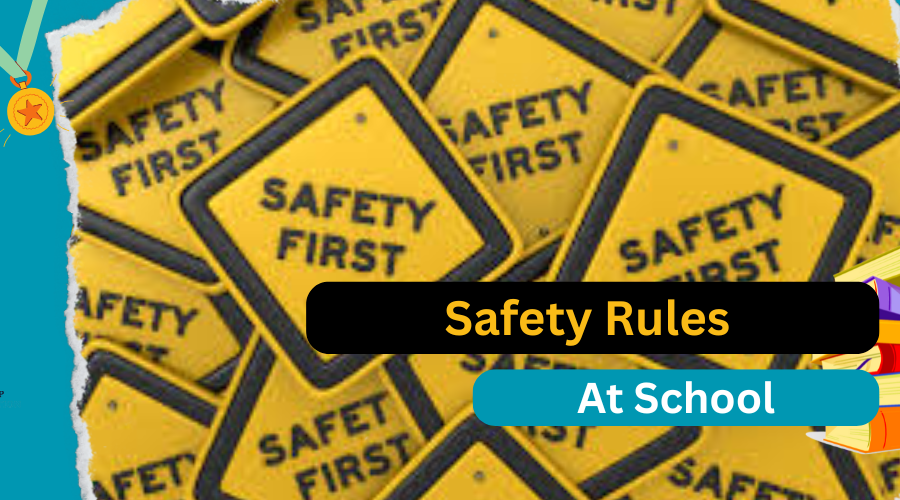Safety is one of the most important aspects of a healthy school environment. When students feel safe, they can focus better on learning, build positive relationships, and grow in confidence. Whether it’s physical safety, emotional well-being, or protection from emergencies — important safety rules for students help everyone stay protected and supported.
In this guide, we share the Top 10 essential safety rules every student must follow — plus useful tips on emergency safety, personal safety, and how schools can maintain a safe space for all.
Why Are School Safety Rules Important?
School safety rules are not just guidelines — they are life lessons that teach responsibility, care for others, and how to act in unexpected situations.
Here’s why school safety guidelines are so important:
✅ Prevent accidents — like slips, falls, injuries in playground or labs
✅ Promote discipline and respectful behavior
✅ Prepare students to handle emergencies (fire, earthquake, medical issues)
✅ Support personal well-being — preventing bullying or harassment
✅ Build a positive learning space where all students feel secure
Whether it’s inside classrooms, during sports, or on the school bus — following these safety measures in school is everyone’s responsibility.
Top 10 Essential Safety Rules at School
1️⃣ Always Follow Classroom Rules
Classroom rules are not just about discipline — they are essential for safety, smooth learning, and mutual respect. These rules are often based on age-appropriate guidelines to keep students safe from accidents and distractions.
Why it matters:
Ignoring rules like standing on chairs, throwing objects, or misusing supplies can result in injury. Orderly behavior protects both the student and their peers.
Real-life examples:
- A student tripping over a bag left in the aisle
- A classmate getting hurt by someone tossing sharp stationery
Student-friendly reminder:
👉 Think before you act — one careless moment can hurt someone.
2️⃣ Walk, don’t run, in school corridors
Running in school, especially in hallways or on stairs, is one of the most common causes of school-time injuries. Slippery floors, crowded hallways, and sharp corners increase the risk.
Why it matters:
Even if you\’re late, walking calmly prevents falls, collisions, and panic. It also shows consideration for younger children and teachers around.
Real-life examples:
- A child running down stairs falls and breaks an arm
- A collision causes both students to drop and damage their school materials
Student-friendly reminder:
👉 You’re not in a race — arrive safe, not sorry.
3️⃣ Keep Hands and Feet to Yourself
Pushing, hitting, tripping, or touching others without consent is unsafe and can lead to serious injuries or emotional distress — even if it\’s done \”as a joke.\”
Why it matters:
Physical boundaries teach self-control, mutual respect, and prevent bullying or violence.
Real-life examples:
- A playful push during lining up turns into a head injury
- A student feels uncomfortable or scared by repeated poking or touching
Student-friendly reminder:
👉 Keep your hands for helping, not hurting.
4️⃣ Know and Follow Emergency Procedures
Every school has emergency plans for fire, lockdown, earthquake, or medical emergencies. Drills may feel boring, but they prepare you to respond calmly and correctly during real incidents.
Why it matters:
Panicking during emergencies can lead to stampedes, miscommunication, or injuries. Knowing your role saves lives.
What students should memorize:
- Evacuation routes
- Bell sounds and what they mean
- Whom to follow and where to gather
- Who to inform in case of injury or panic
Student-friendly reminder:
👉 A calm student is a safe student during an emergency.
5️⃣ Report unsafe behavior or damaged property
Staying silent when you or someone else is in danger can make things worse. Unsafe behavior can be physical, verbal, or emotional, and it must be reported immediately.
Why it matters:
Teachers and adults can only help when they know what’s going on. Reporting is not “tattling” — it’s protecting your safety and someone else’s well-being.
Unsafe situations to report:
- Being bullied or seeing someone else bullied
- Dangerous games or dares
- Threats, verbal abuse, or stealing
- Suspicious strangers near school premises
Student-friendly reminder:
👉 Be brave. Speak up. You might save someone from harm.
6️⃣ Stay Within School Boundaries
School boundaries are there to ensure your safety. Leaving campus without permission puts you at risk of getting lost, hurt, or exposed to unsafe environments.
Why it matters:
Staff are trained to help inside the campus — outside, they may not be able to reach you in time.
Situations to avoid:
- Sneaking out during lunch or recess
- Taking a shortcut home without informing anyone
- Hiding in unsupervised areas like rooftops or storerooms
Student-friendly reminder:
👉 Inside school = protected. Outside without permission = unsafe.
7️⃣ Practice Good Hygiene and Cleanliness
Hygiene isn’t just about looking clean — it’s about staying healthy and preventing the spread of illness to others.
Why it matters:
Schools are common places for spreading germs and viruses. Maintaining personal hygiene is a form of responsibility to yourself and your classmates.
Key habits to build:
- Wash hands before eating and after using the toilet
- Use tissues or elbow to cover sneezes
- Dispose of waste properly in dustbins
- Keep your desk, bag, and water bottle clean
Student-friendly reminder:
👉 Clean hands = fewer sick days = more fun in school!
8️⃣ Use School Equipment Properly
School supplies and equipment — whether in science labs, art rooms, or sports grounds — can be dangerous if misused or handled without care.
Why it matters:
Even small tools like scissors or lab chemicals can cause injury if used incorrectly. Schools provide equipment for learning, not for playing or experimenting unsafely.
Examples:
- Never switch on lab equipment without supervision
- Don’t misuse sports gear or climb on furniture
- Return borrowed items properly after use
Student-friendly reminder:
👉 Respect the tools. Use them the right way, the safe way.
9️⃣ Stay Alert Around School Transport
Buses and vans are large moving vehicles. A moment of carelessness near them can lead to serious accidents.
Why it matters:
Children are often excited or in a hurry while boarding, but safety must come first.
Transport safety checklist:
- Arrive at the bus stop early
- Stand in a queue while boarding
- Wait for the bus to stop completely before approaching
- Stay seated and don’t distract the driver
Student-friendly reminder:
👉 The safest ride home starts with safe behavior at the bus stop.
🔟 Know Who to Contact in an Emergency
During sickness, injury, or uncomfortable situations, knowing the right adult to approach is essential. Sometimes students panic or feel confused — preparation helps.
Why it matters:
Immediate help prevents bigger problems. Knowing who’s responsible builds trust and safety.
Emergency contacts to memorize or keep written:
- Class teacher
- School nurse or counselor
- Head of department or principal
- A trusted staff member or friend
Student-friendly reminder:
👉 Don’t wait. Speak to someone who can help — your safety is important.
Additional Safety Measures in School
Beyond the basic classroom rules, every school should have clear safety measures to handle various situations and keep the entire school community secure. These include:
✅ Fire safety drills
Schools must conduct regular fire drills so that students and staff know how to evacuate safely in case of a fire.
✅ Earthquake safety
In regions prone to earthquakes, schools should teach students how to protect themselves — such as “Drop, Cover, and Hold.”
✅ First-aid readiness
A first-aid kit should be available in all school blocks, and staff should be trained in basic first-aid to handle minor injuries or sudden health issues.
✅ School transport safety
Buses should be well-maintained, with trained drivers and attendants. Students should know basic school safety tips for students while traveling.
✅ Cyber safety rules
In today’s digital world, it’s important to educate students about responsible internet use, online privacy, and how to report cyberbullying.
✅ Handling bullying & harassment
Schools must have clear anti-bullying policies. Students should know whom to approach if they or their friends experience bullying.
Emergency Safety Rules at School
Emergencies can happen unexpectedly — being prepared is key. Every student should know:
✅ Fire evacuation steps
Know the nearest exit routes, fire alarms, and assembly points. Never use elevators during a fire.
✅ What to do in lockdown situations
Stay calm, follow teacher\’s instructions, remain quiet, and stay away from windows.
✅ Who to contact during emergencies
Memorize key contacts — school nurse, principal, trusted teachers.
✅ Safe assembly points
Always proceed to the correct assembly area during drills or emergencies.
✅ Emergency contact list
Keep a list of personal emergency contacts (parents/guardians) with the school office and on your person if allowed.
Personal Safety Rules for Students
Beyond school-wide rules, personal safety tips for students empower them to protect themselves:
✅ Do not talk to strangers
Whether on school premises or on the way to and from school, avoid unknown people.
✅ Keep emergency contact numbers handy
Learn parents’ numbers and the school’s emergency number.
✅ Stay within school boundaries
Do not leave the school premises without permission.
✅ Travel in groups if possible
When going to school events or home, stay with friends or trusted adults.
✅ Inform parents about whereabouts
Always let parents know if you’re staying late at school or going somewhere after school.
Conclusion
Creating a safe school environment is a shared responsibility between students, teachers, parents, and school management. By following these important safety rules for students, children not only protect themselves but also contribute to a secure and positive learning space for everyone.
Whether it’s staying alert in the classroom, learning emergency procedures, or practicing good hygiene, small daily actions can make a big difference. Students should feel empowered to speak up about unsafe situations and trust adults to help.
Let’s work together to build a school environment where safety comes first — because a safe student is a confident learner! 🚸🎒
FAQ Section
Q1. Why are school safety guidelines important?
School safety guidelines protect students from accidents, injuries, bullying, and emergencies. They create a secure learning atmosphere where students can focus on studies.
Q2. What are personal safety tips for students?
Avoid talking to strangers, stay within school boundaries, travel with friends, inform parents about your plans, and report anything that feels unsafe.
Q3. How should students respond during emergencies?
Stay calm, follow teacher instructions, know evacuation routes, and proceed to safe assembly areas.
Q4. What are some basic safety measures in school?
Fire drills, first-aid training, earthquake safety, cyber safety, clean environments, and clear emergency procedures.
Q5. What role do parents and teachers play in school safety?
Teachers guide students and implement safety rules. Parents should educate children about personal safety and maintain communication with the school.





